Top News
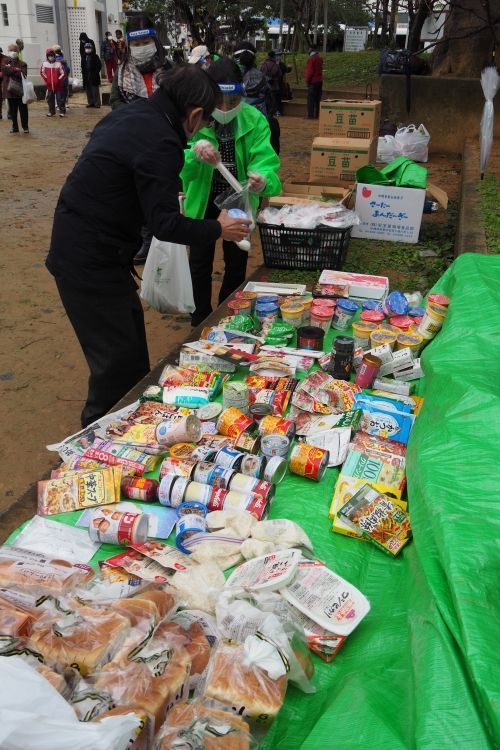
January 12, 2020 Ryukyu Shimpo
By Naoki Isa
In order to support those who have fallen on hard times due to the coronavirus pandemic, the volunteer organization “Yuimaru no Kai” has been running a food drive twice per week at Makishi Park in Naha. Group representative Naomi Kadekaru, 65, said, “Leave no one behind. We want everyone, both young and old, to take what they need.”
The Yuimaru no Kai was formed in June of 2020, setting up donation boxes for food and money in the plaza in front of Cargoes in Asato, Naha, where people could come and make donations at their leisure. They finished collecting donations in September, and started distributing food in October in Makishi Park. The food was distributed to people including those with children in need.
In October, 125 people visited the park to accept food, and the number continued to climb from there, with 209 people visiting in November, and 272 people visiting in December. The age of the visitors ranged from 40-90. Visitors came not only from Makishi and Asato, but also Akebono and Kokuba.
Food was purchased from the Okinawa Community Chest’s “Red feather coronavirus assistance program,” and there were also donations from local businesses and the catholic church. Masks and other disease prevention materials were provided by the Okinawa Prefecture Amusement Industry Cooperative’s Okiyukyu pp grant.
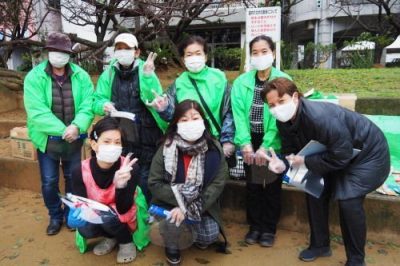
Naomi Kadekaru (back row, third from the right) and Yuimaru no Kai members
Under a cold sky on January 8, 36 people gathered to accept food. One was a 70-year-old woman who used to work a register 5 days a week at a food store in Kokusai-dori, her hours were cut back to only 2 days per week. “Many of the people who come for food are elderly who live alone. This has become a place for us to chat and socialize,” she said smiling. A 62-year-old man said, “I had a job as a construction worker, but I got sick and left my job. I work as a day laborer but it doesn’t pay much, and the food distribution is very helpful.”
Kadekaru explained, “As long as we have funding, we want to continue. Our goal is to distribute food to 500 people per month. It would also be great for the young people to continue to volunteer.”
Food distribution takes place generally on Tuesdays and Fridays from 9:30-10:30 a.m., and if they have to cancel due to weather, they distribute on Saturday. Food donations (excluding expired food and alcohol) are still welcome. For inquiries, please contact Naomi Kadekaru at 090 (3793) 7906.
(English translation by T&CT and Sam Grieb)
Go to Japanese
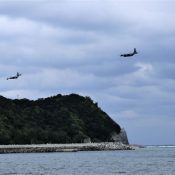
January 9, 2021 Ryukyu Shimpo
In the latest issue of U.S. military aircraft repeatedly flying at low altitudes around Kerama Islands, Japan’s Ministry of Defense and the Foreign Minister indicated their approval of the U.S. military training outside of the training area. In response, the mayors of Zamami and Tokashiki Villages objected during an interview with this newspaper on January 8, stating, “We ask [the military to] stop training inside our residential areas.”
Satoru Miyazato, mayor of Zamami Village, said, “Military training in residential areas—it has got to be a joke. We are grateful for the Minister’s prompt request to the U.S. in addressing this matter. Still, if the situation persists and people are left worried, we will push back to provide our residents with safe and secure living conditions.” Hidekatsu Zamami, mayor of Tokashiki Village, said, “Obviously, we would like the training in our residential areas to discontinue. If it persists, we will engage the appropriate authorities to block the drills from taking place in spheres of human habitation.”
“The Japan-U.S. Status of Forces Agreement needs to be revised,” says Gov. Denny Tamaki
When asked at a press conference on January 8 about his views on the issue of low-flying U.S. military aircraft around the Kerama Islands, Governor Denny Tamaki replied, “To protect the safety and security of the people of Okinawa, the Japan-U.S. Status of Forces Agreement needs to be revised, which I will continue to demand.” He emphasized, “We can robustly regulate the airspace privileges granted to the U.S. military by applying domestic laws.”
The Okinawa Prefectural Government is currently considering requesting the U.S. military and the Japanese government to discontinue the low-altitude flights. On January 7, it received confirmation from the Defense Bureau that the U.S. military did conduct the exercise in question. The prefecture is asking for more details, including the purpose of the drills.
(English translation by T&CT and Monica Shingaki)
Go to Japanese
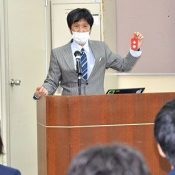
January 8, 2021 Ryukyu Shimpo
Recently, Mr. Hiroshi Ueno, a teacher at Okinawa Shogaku Junior and Senior High Schools, presented “Lessons for Life,” speaking to third-year junior high school students about his own experience battling cancer. Ueno was diagnosed with pancreatic cancer in July 2018. His cancer was stage 4, the most advanced form, but with surgery and treatment with anti-cancer drugs, Ueno was able to return to work. He would sometimes speak about his illness during class, but this was the first time he gave a talk focusing on it.
Just before the school team departed for an international competition, Ueno realized that he had jaundice. His doctor recommended immediate hospitalization, but Ueno knew that if he checked into the hospital his students would not be able to go to the competition. He decided to go to the competition in the United States. Upon his return to Japan, a test revealed that he had cancer.
Ueno spoke about the difficulties of his treatment with anti-cancer drugs, for example, losing his sense of taste. He said, “I could feel the rice I put into my mouth, but I couldn’t taste it. It was like eating sand.” The most difficult part, he told students, was “not being able to come to school.”
Cancer education is included in new educational guidelines for junior high school that will be implemented from 2021. Ueno received training in cancer education prior to giving his lecture and he shared what he learned with the students. He explained that there are many varieties of cancer and symptoms are diverse. He also spoke about how cancer can be linked to factors such as viruses, lifestyle, or genetics, but that these are only risk factors. There are also cases where the cause of the cancer is unknown.
He also spoke about the risk of recurrence, saying, “it’s not scary to me now. If it comes back, I’m thinking I’ll name my cancer ‘stubborn brat.’ It’s just something I’ll have to live with.”
To the students, he offered this advice: “In your lives, there may be things that are so difficult that you feel like you want to die. But I want you to remember: difficulty is the spice of life. If you ate delicious cake every day, it wouldn’t be as delicious. It’s delicious precisely because we have sour things and spicy things as well.” He added, “People will eventually die. I want to live my life to the fullest with everything I have.”
(English translation by T&CT and Ellen Huntley)
Go to Japanese
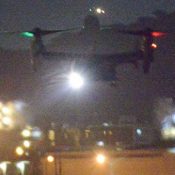
January 7, 2021 Ryukyu Shimpo
Vertical takeoff and landing (VTOL) MV-22 Osprey transport aircraft, among other types of aircraft, flew over Ginowan City approaching from the south and landed on the runway of Futenma Air Station, even after 10:00 p.m., on January 5 and 6. According to noise measurements taken by the Okinawa Prefecture and Ginowan City governments on January 5 at Ueojana Community Hall south of the runway, noise at 9:53 p.m. reached the maximum level of the day of 101.0 decibels, noise at 10:03 p.m. was 92.2 decibels, and twice between 10:14 and 10:28 p.m. noise was as high as 89.0 decibels.
The base damage phone number 110 for Ginowan received 14 complaints on January 5, including “there have been sounds like explosions all day long”, “I can’t sleep”, and “the low-altitude flying is loud”. Ginowan City is sending these complaints to the US armed forces and Okinawa Defense Bureau and requesting that consideration be given to civilians’ daily lives. A notice to airmen (NOTAM) from the U.S. armed forces says that Futenma Air Station will be used from 7:00 a.m. to 11:00 p.m. on January 5-7. On January 6, U.S. Navy P-8 anti-submarine patrol aircraft from overseas repeatedly took off from and landed at Futenma Air Station.
(English translation by T&CT and Erin Jones)
Go to Japanese
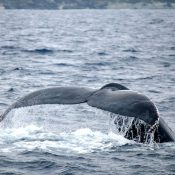
January 6, 2021 Ryukyu Shimpo
By Hirokazu Otsubo
The Zamami Whale Watching Association (ZWWA) reopened the whale watching season December 27, launching their first tour on December 29. The postponed tours on the 28th due to poor weather. On December 22, there were reports a whale sighting aboard a regular high-speed ferry.
Around 11:00 a.m. on the 29th, a whale spotter observed a spout in the water around three kilometers north-east Zamami Island from the Inazaki Observatory, after which they set out on a whale watching boat around noon. Around 10 minutes after embarking the watchers encountered two humpback whales as part of an enjoyable two-hour tour.
Ship captain and photographer Hiroji Sano, 47, said, “I’m glad that the first tour went smoothly and that we were able to meet some whales. Since the whales breached shortly after departing, almost all of the passengers were able to see it, which was great.”
The association plans on running tours through April 5.
(English translation by T&CT and Sam Grieb)
Go to Japanese
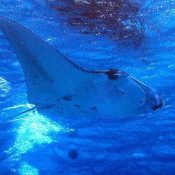
January 7, 2021 Ryukyu Shimpo
By Hideaki Yoneda
At around 2 p.m. on December 27, Yuriko Nishiura, manager of the dive shop Shima Ashibi in Tokashiki Village, successfully photographed a giant manta ray swimming at a depth of about four meters around Hanari Island, an uninhabited island located about one kilometer from Aharen Beach in Tokashiki.
Nishiura was guiding a couple on a diving tour at Hanari Island; the couple visited Tokashiki Village after having to cancel their overseas honeymoon trip due to the novel coronavirus. The group encountered a manta ray that was about five meters long and enjoyed its elegance as the sea creature swam leisurely alongside the boat for the entire tour duration.
Nishiura, who has been diving in Tokashiki for 23 years, said, “We rarely see giant manta rays while diving around Tokashiki Island, but this is my first time seeing one around Hanari Island. It was as if it was congratulating the newlyweds. I hope to see more manta rays near Hanari Island.”
(English translation by T&CT and Monica Shingaki)
Go To Japanese
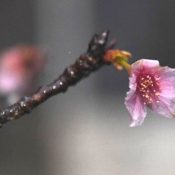
January 5, 2021 Ryukyu Shimpo
On January 4, the Okinawa Regional Headquarters of the Japan Meteorological Agency (JMA) announced that the hikanzakura cherry trees in Naha started blooming on that day and that the plum trees had started blooming on December 31, 2020. The hikanzakura cherry trees started blooming 14 days earlier than average, and two days earlier than the preceding year. The plum trees started blooming 15 days earlier than average and six days earlier than the preceding year.
The Okinawa area saw clouds and rain on January 4 as a result of a valley in the air pressure. The highest temperature was 24.3 degrees in Kyuto, Minamidaito Village, and 24.2 degrees in Minamidaito in the same village, equivalent to the average temperatures in mid-April. Naha recorded a high of 22.6 degrees.
According to the Okinawa Regional Headquarters of the JMA, clouds and rain are expected on January 5 in the Okinawa area as a result of cold following the front arising in the adjacent seas and the incoming high air pressure from the continent. Storms are expected to pick up in the Sakishima Islands.
(English translation by T&CT and Sandi Aritza)
Go to Japanese
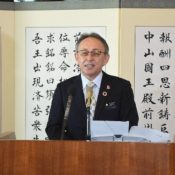
January 5, 2021 Ryukyu Shimpo
On January 4, the first working day of 2021, Governor Denny Tamaki delivered his New Year’s address at the Okinawa Prefectural Government Office. In his speech, the governor positioned alleviating child poverty as “the most important policy for the prefectural government” and said, “the importance [of these measures] is increasing due to the novel coronavirus pandemic.” He added, “In addition to achieving a society in which children can grow up in good health, we will continue to improve the quality of work in Okinawa, including raising the income per capita and expanding full-time employment.”
The governor looked back on the previous year as “a year in which Okinawans came together in the face of unprecedented hardship.” With regard to the novel coronavirus pandemic, Governor Tamaki stated, “Okinawa’s socio-economic situation and the livelihood of its people continue to be in peril.” He emphasized that “we are doing all that we can to maintain a societal safety net, even under these challenging circumstances.”
Tamaki also spoke on the new Okinawa Promotion and Development Plan: “Our societal situation has changed drastically; we must think ahead to life ‘with corona’ and ‘after corona’ and implement a medium- to long-term development plan.” He highlighted incorporating the principles underlying the United Nations Sustainable Development Goals (SDGs) into the new plan.
On the topic of U.S. military base issues, he stated, “I strongly urge the government to eliminate the dangers of the Marine Corps Air Station Futenma as soon as possible, including the immediate suspension of its operations, and its closure and return.” He added, “We will work tirelessly to resolve the various issues arising from the bases, starting with a fundamental review of the consolidation and downsizing of U.S. military bases in Okinawa and the Japan-U.S. Status of Forces Agreement.”
(English translation by T&CT and Monica Shingaki)
Go to Japanese
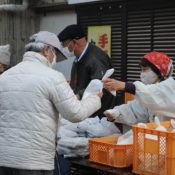
January 3, 2021 Ryukyu Shimpo
In order to support day laborers and those in need over the New Year holiday, the Okinawa – Shuri Day Laborer’s Union (Okinichiro) handed out food, hand warmers, and clothing at Yogi park in Naha from December 31 through January 2. Over those days, they handed out 80-100 meals worth of lunch boxes, beverages, and dinners, and some of the people who came to collect meals were those who had lost their jobs due to the coronavirus.
Costs for the food support were covered by a fund-raising campaign, and the clothes were provided by donations and approved by volunteers. One of the members of Okinichiro who worked on the campaign (male, 65) emphasized, “Jobs are disappearing more and more due to the coronavirus. People are struggling supporting themselves or even working together. Public assistance such as social security is necessary.”
(English translation by T&CT and Sam Grieb)
Go to Japanese
January 1, 2021 Ryukyu Shimpo
A new year is upon us. The year 2021 will be the time for Okinawa to decide its future direction, as the 50th anniversary of Okinawa’s reversion to Japanese rule is nearing.
Fifty years ago, in November 1971, the Ryukyu government drew up a proposal for reintegration measures, which outlined how Okinawa should be after its return to Japan.
Chobyo Yara, who led the reversion movement, clearly stated in the proposal’s introduction section: “Too often Okinawa had become prey to, and was exploited by, state and military base authorities. Okinawa must break free from this position at this turning point in history.”
This was Yara’s declaration that Okinawa will break away from its history of being exploited by the state, including the annexation of Ryukyu, the Battle of Okinawa, and the U.S. occupation; a declaration that Okinawa will not be taken advantage of again. Yara also stated that U.S. military bases are the root of evil, as they violate human rights and disrupt Okinawans’ daily lives. He sought to be freed from the oppression of the Japanese government’s imposition of the bases on Okinawa and guaranteed human rights.
Unfortunately, the current situation is quite the opposite of his vision. The U.S. returned control of Okinawa to Japan in 1972, but even after the reversion, the U.S. continues to freely use its military bases in Okinawa with the Japanese government’s approval.
Pushing forward the construction of the new Henoko base in Nago, against public opposition, is nothing short of a declaration that the U.S. will continue to exploit Okinawa. What was Yara striving for in the 1971 proposal? In the introduction, Yara states that the prefecture’s top priority is the welfare of Okinawans and calls for (1) respect for Okinawan autonomy, (2) pursuit of peace, (3) restoration of human rights under the pacifist constitution, and (4) locally-led economic development.
The proposal asserted that Okinawa would exercise its right to self-determination to create a new prefecture and establish the four pillars. It insisted the Japanese government be held accountable and budget for plans drawn up by Okinawa.
The proposal’s concept differed drastically from the Japanese government’s view that it is the ultimate authority on Okinawa’s promotion and development plans.
However, the ruling Liberal Democratic Party forcibly adopted the Okinawa Reversion Agreement by force of numbers, before the Diet received the proposal. Okinawa’s last appeal was not heard.
Meanwhile, the Act on Special Measures for the Promotion and Development of Okinawa will expire at the end of fiscal 2021. Drafting a new development plan for Okinawa, 50 years after its reversion, is now in full swing. If the central government attempts to use Okinawa’s economic development as a bargaining chip to negotiate military base issues, it must be resolutely rejected. We should not forget that our forefathers refused to be treated as a means by powerful nations half a century ago.
This year, the prefecture will formally propose a new Okinawa development system to the national government. The new plan positions the United Nations’ Sustainable Development Goals (SDGs) as goals for Okinawan development. It makes sense for Okinawa to use the U.N. SDGs framework. Human Rights issues are the bedrock to SDGs, and its aims are already included in Yara’s original proposal.
The key is for Okinawans to become self-reliant in overcoming any issues and come together and take the first step to address challenges. The new year brings new hope to this undertaking.
(English translation by T&CT and Monica Shingaki)
Go to Japanese
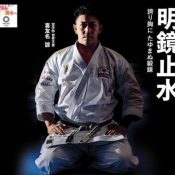
January 1, 2021 Ryukyu Shimpo
By Shun Furukawa
Ryuei-ryu karate is one of the origins of karate, incorporating the flowing motions of Naha-te. It has been over 200 years since the birth of its second-generation grandmaster, Norisato Nakaima. Ryo Kiyuna has inherited the lessons of the style, and continues to explore the meanings buried in the kata created by his predecessors. “Ryuei-ryu is a form of karate that connects all the way back to master Nakaima. While I have not nearly done enough, I want to continue researching the nuances of the techniques, and express them with my body.” As always, he bears the pride of Okinawan karate on his chest, and takes on the world.
Ryuei-ryu bears essential characteristics such as intervals of “one foot, two fists,” and a unification of movements between offensive and defensive moves. Fourth-generation grandmaster Kenko Nakaima had a saying, “The techniques gush forth like a fountain.” One thrusts and kicks as if it were a relentless interrogation with no space for an answer. There is a profundity to even the most basic moves.
The exploration continues for even a single thrust. While in Series A (Australia) in 2017, Kiyuna found a new sensation of “thrusting with the entirety of his body.” “When you become aware of somewhere, you can thrust even faster and stronger. You notice a variety of things from training every day.”
His teacher, Tsuguo Sakumoto, prioritizes Okinawan individuality as much as possible. In training, words like muchimi, which means to move as if you were stuck to something, and wabagutu, which he uses to admonish unnecessary movement. Sakumoto teaches not only unarmed methods, but also traditional weapon-based techniques using staves and sai.
Kiyuna trains tirelessly every day to reproduce a karate that was created for real combat that would decide life or death. “If I perform the kata that I am always training with, the results will follow.” His countless achievements are born from this everyday training, and attention to the dignity of the traditional techniques that have been passed from generation to generation.
Ryo Kiyuna
Born in Okinawa City July 12, 1990. Kiyuna has three consecutive world championships, and 19 titles in the KARATE1 Premier League, a feat which has been recognized in the Guinness Book of World Records.
In December of 2020 he won his ninth-straight All-Japan Emperor’s Cup, an all-time high for consecutive wins. He went to Konan High School in Naha before studying at Okinawa International University. He belongs to the Ryuei-ryu Ryuhou-kai organization.
(Photograph by Moriaki Kise)
(English translation by T&CT and Sam Grieb)
Go to Japanese











 Webcam(Kokusai Street)
Webcam(Kokusai Street)


